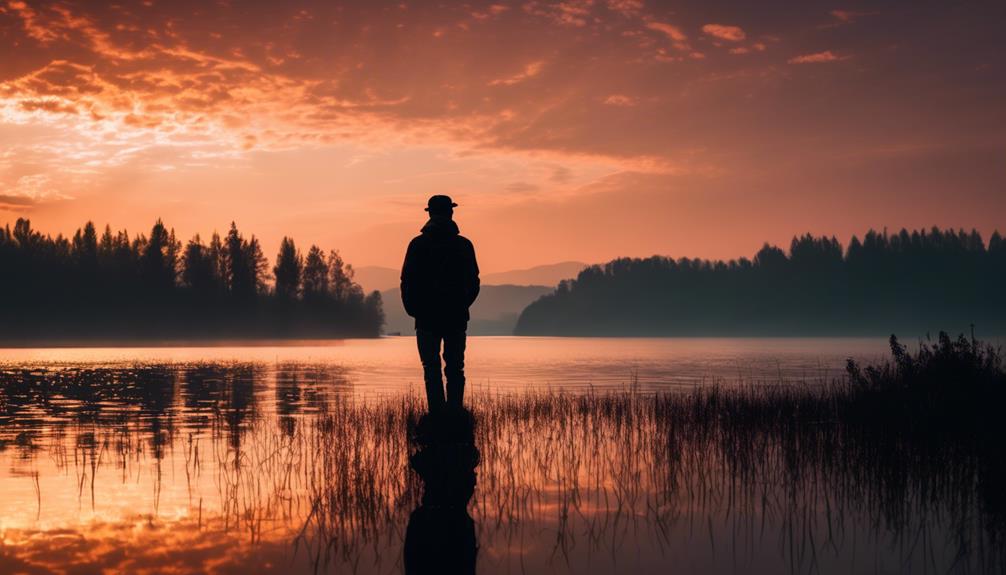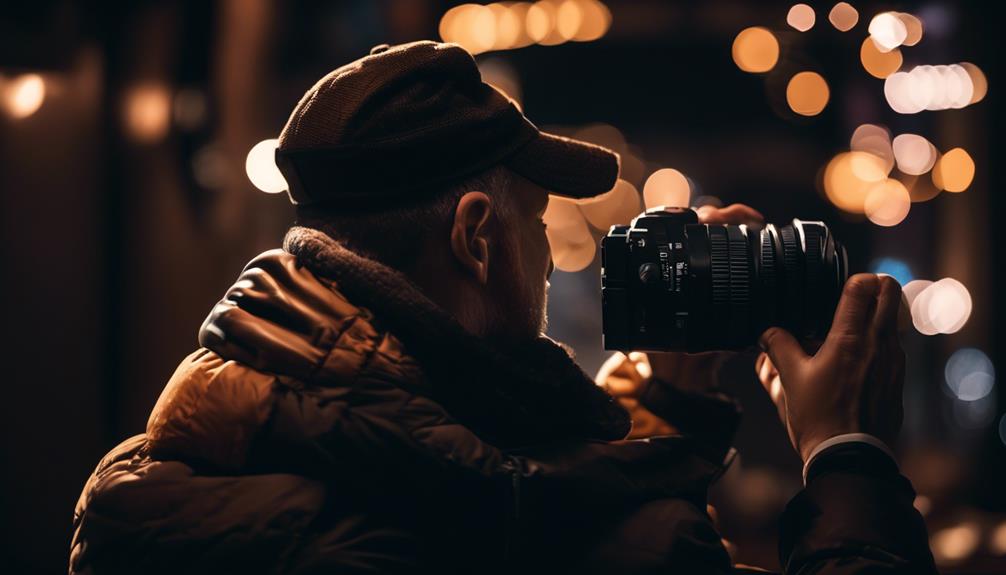Please note this post may contain affiliate links picked by me (Jay) that I have deemed may be of interest or relevant to you the reader of this.
These links do not affect the cost of the thing if you decide to purchase but i may get a little money if you choose to purchase.
For more information on my affiliate link policy click here.
As I gaze upon the iconic photograph of Dorothea Lange's 'Migrant Mother,' I am reminded of the power and influence that photography holds. It is a medium that captures not just moments, but emotions, stories, and sometimes even controversy.
But with this power comes a great responsibility, one that photographers must navigate with care and respect. In this discussion, we will explore the guiding principles that shape the ethics of photography inspiration.
From the replication of iconic photographs to the portrayal of marginalized communities, we will delve into the ethical implications that photographers face in their pursuit of artistic expression. Join me as we uncover the complexities of this fascinating and ever-evolving field.
Key Takeaways
- Copyright infringement is a major ethical concern when replicating iconic photographs, and seeking permission and giving proper credit is important in navigating the ethics of replication.
- Photographers have the responsibility to portray marginalized communities with cultural sensitivity, understanding the context, avoiding harmful stereotypes, and giving agency and voice to the individuals being photographed.
- Balancing artistic expression and respecting subjects' privacy is crucial, prioritizing well-being, dignity, consent, cultural sensitivity, representation, empathy, confidentiality, anonymity, and securing trust.
- Digital manipulation raises questions about the integrity and authenticity of the image, and transparency, disclosure, and maintaining trust with the audience are key when images are digitally altered.
Ethical Implications of Replicating Iconic Photographs
Replicating iconic photographs raises important ethical questions and prompts us to examine the intersection of art, creativity, and originality. One of the main ethical implications of replicating these photographs is the issue of copyright infringement. When we recreate an iconic photograph without the permission of the original photographer or copyright holder, we're essentially stealing their intellectual property. This raises questions about the value we place on artistic expression and the rights of creators to protect their work.
However, there's also an argument to be made for historical preservation. By replicating iconic photographs, we're able to pay homage to the original work and keep it alive in our collective memory. It allows us to appreciate the skill and vision of the original photographer while also bringing their work to a new audience.
Navigating the ethical implications of replicating iconic photographs requires a delicate balance between honoring the original artist's rights and preserving the historical significance of the image. It's important to approach this practice with respect and understanding, seeking permission from the copyright holder whenever possible and giving proper credit to the original photographer.
The Responsibility of Photographers in Portraying Marginalized Communities
Photographers have a crucial responsibility when it comes to portraying marginalized communities. As image-makers, we've the power to shape perceptions, challenge stereotypes, and amplify voices that are often silenced. Representation isn't just about capturing an image; it's about accurately and respectfully depicting the lived experiences of individuals and communities who've been historically marginalized.
Cultural sensitivity is at the heart of responsible photography. It requires us to approach our subjects with empathy, respect, and a willingness to listen and learn. We must take the time to understand the cultural context in which our subjects exist, and to avoid perpetuating harmful stereotypes or exploiting their vulnerability.
It is important to recognize that our role as photographers isn't to tell someone else's story, but rather to provide a platform for them to share their own narrative. This means giving agency and voice to the individuals we photograph, and involving them in the creative process. We must also be mindful of the power dynamics at play and ensure that our work doesn't further marginalize or exploit those we aim to represent.
Balancing Artistic Expression and Respect for Subjects' Privacy
Finding the right balance between artistic expression and respecting the privacy of our subjects is a delicate yet essential aspect of ethical photography. As photographers, we have the responsibility to capture captivating images while also considering the ethical implications of our work.
When it comes to artistic boundaries, it is crucial to recognize that there is a fine line between pushing boundaries and violating the privacy of our subjects. While it is important to push the boundaries of creativity and innovation, we must always prioritize the well-being and dignity of those we photograph.
To help navigate this delicate balance, here are some ethical considerations to keep in mind:
| Ethical Considerations | Artistic Expression | Respect for Subjects' Privacy |
|---|---|---|
| Consent | Experimentation | Confidentiality |
| Cultural Sensitivity | Creativity | Anonymity |
| Representation | Innovation | Safeguarding personal details |
| Empathy | Breaking conventions | Securing trust |
The Ethics of Digital Manipulation in Photography
As we explore the realm of ethical considerations in photography, it's essential to address the increasingly prevalent issue of the ethics surrounding digital manipulation in our craft. With the advancement of technology, digital alteration has become a common practice in the field of photography. While digital manipulation allows for creative expression and artistic experimentation, it also raises important questions about the integrity and authenticity of the image.
In the realm of photojournalism ethics, the use of digital manipulation can be particularly controversial. Photojournalists have a responsibility to document the truth and present accurate representations of events. Manipulating images in a way that distorts or misrepresents reality undermines the trust between the photographer and the audience.
However, it's important to note that not all digital manipulation in photography is unethical. Minor adjustments such as color correction or cropping are commonly accepted practices that help enhance the visual impact of an image. The key lies in transparency and disclosure. If a photograph has been digitally altered beyond these minor adjustments, it's crucial for photographers to disclose this information to maintain trust with their audience.
Navigating the Boundaries of Consent and Exploitation in Photography
How can photographers navigate the boundaries of consent and exploitation in their work?
Photography is a powerful medium that can capture profound moments and evoke emotions. However, it's essential for photographers to understand and respect the ethical boundaries surrounding consent and exploitation. By doing so, they can ensure that their work maintains integrity and respects the rights and dignity of their subjects.
Here are three key considerations for navigating these boundaries:
- Seek informed consent: Before photographing individuals, it's crucial to obtain their informed consent. This means explaining the purpose of the photograph, how it will be used, and any potential risks or implications. By obtaining explicit consent, photographers can establish a respectful and collaborative relationship with their subjects.
- Respect privacy and autonomy: When photographing people, it's important to respect their privacy and autonomy. This involves being mindful of personal boundaries and cultural sensitivities. Photographers should avoid exploiting vulnerable individuals or using their images in a way that could harm them or invade their privacy.
- Reflect on power dynamics: Photographers hold a certain level of power and influence through their work. It's essential to be aware of this power dynamic and to use it responsibly. This includes considering the impact of the photographs on the subjects and the wider audience. Photographers should aim to challenge stereotypes, spark conversations, and promote social justice through their images.
Frequently Asked Questions
How Can Photographers Ensure That Their Replication of Iconic Photographs Does Not Infringe on Copyright Laws?
To ensure that my replication of iconic photographs doesn't infringe on copyright laws, I take ethical replication seriously.
Firstly, I thoroughly research the copyright status of the original image and obtain proper permissions if necessary.
Additionally, I strive to add my own unique perspective and creative elements to the replication, ensuring that it's transformative and not a mere copy.
What Are Some Examples of Marginalized Communities That Are Often Misrepresented in Photography, and How Can Photographers Responsibly Portray Them?
As a photographer, it's important for me to responsibly portray marginalized communities in my work.
One example of a marginalized community that's often misrepresented in photography is indigenous communities. They face numerous challenges, including cultural appropriation and misrepresentation.
Another example is the LGBTQ+ community, who've historically been subjected to stereotypes and discrimination.
To ethically represent these communities, I must approach them with respect, listen to their stories, and work collaboratively to ensure their voices are heard and their experiences are accurately portrayed.
How Can Photographers Strike a Balance Between Artistic Expression and Respecting the Privacy of Their Subjects, Especially in Candid or Street Photography?
When it comes to striking a balance between artistic expression and respecting the privacy of my subjects, especially in candid or street photography, I believe it's crucial to navigate the ethical boundaries and approach the situation with cultural sensitivity.
It's important to capture authentic moments while still being mindful of the privacy and cultural values of those I'm photographing.
What Are Some Ethical Guidelines That Photographers Should Follow When Digitally Manipulating Photographs, Particularly When It Comes to Altering the Appearance of Individuals or Changing the Context of a Photograph?
As a photographer, my responsibility lies in ensuring the integrity of my work, even when digitally manipulating photographs. The impact of such manipulation can be profound, especially when altering the appearance of individuals or changing the context of a photograph.
To maintain ethical guidelines, I strive for transparency and honesty in my editing process. I aim to preserve the authenticity of the moment captured, while still allowing room for artistic expression. This balance allows me to create innovative and thought-provoking work, all while upholding the principles of ethical photography.
How Can Photographers Navigate the Boundaries of Consent and Avoid Exploiting Their Subjects, Especially in Situations Where Language or Cultural Barriers May Exist?
Navigating the boundaries of consent and avoiding exploitation in photography can be challenging, especially when faced with language or cultural barriers.
It's crucial to approach subjects with cultural sensitivity, respecting their customs and beliefs. Informed consent should always be sought, ensuring subjects understand how their images will be used.
Building trust and communication is key, allowing for open dialogue and a collaborative approach.
Conclusion
In the vast world of photography, ethics play a crucial role in shaping how we capture and portray the world around us. As we navigate the boundaries of replication, representation, privacy, and manipulation, it's essential to remember that every photograph carries the power to inspire, inform, and impact.
Just as a picture is worth a thousand words, let's remember that behind every photograph lies a story waiting to be told, a perspective waiting to be understood, and a moment waiting to be cherished.

